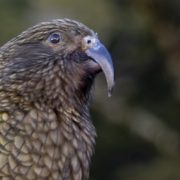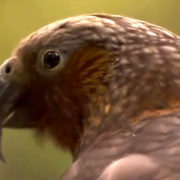Endangered Kea harrassed by DOC
To monitor effects of 1080 poisoning, Kea are harrassed during nesting and year round. Many wear backpacks with transmitters.
Quotes on Harrassment:
“The interests of the bird come first. Birds respond to people in many ways, depending on the species, location and time of year. Disturbance can keep birds from their nests, leaving chicks hungry or enabling predators to take eggs or young…
“Intentional or reckless disturbance of some species at or near the nest is illegal in Britain…
“Disturbance is not just about going too close – a flock of wading birds on the foreshore can be disturbed from a mile away if you stand on the sea wall…
“Repeatedly playing a recording of birdsong or calls to encourage a bird to respond can divert a territorial bird from other important duties, such as feeding its young. Never use playback to attract a species during its breeding season.” – Association of County Recorders and Editors, 2014
“Do not approach nests when young are close to fledging: When the young are disturbed during this stage, they may leave the nest prematurely. Young that fledge prematurely usually do not stay in the nest prematurely despite attempts to put them back, and their survival rates away from or outside the nest are low. So when young birds are fully feathered and very alert, only observe the nest from a distance…
Be wary of nest predators. Avoid leaving tracks that can direct predators to nests. Nest predators are everywhere- on the ground, in vegetation, and in the air- and many are smart enough to watch you…
Also try not to damage or trample vegetation that could expose nests”- Cornell University Lab of Ornithology 2011
“visiting nests to check the contents necessarily results in disturbance of the individuals being studied. Moreover, investigator disturbance may increase the probability of nest predation (Elser and Grand 1993), human scent (Whelan et al. 1994), or nest markers (Picozzi 1995, Yahner and Wright 1985). Human disturbance may also reduce nest attendance or enhance conspicuous behaviour of the parents.” – N. Verboven et al., The Auk, 2001
“One potential nest cavity was visited and there was an attempt to catch the female who was perched close to the site….Four fledglings were caught and transmitters attached…There was quite significant kea activity at the top of the Gibbs track with at least six unbanded birds…Attempts were made to catch as many of these as possible with one team devoting two nights to this task. – C. Mosen, Nestor Notabilis 6, 2014
“When we were checking the nest, I got to crawl inside. It was really interesting, as the cavity was a lot different to what I expected! It was long- I crawled more than my whole body length in – and it was narrow! I had to go in a bit like superman with my arms out in front of me…
“Tomorrow, we were heading to the Hawdon Valley to check on a couple of nests and put bands and transmitters on some chicks- can’t wait!…
“to our surprise, there was a wee chick there! I say wee but he weighed over 1000g. Cory got him out and we weighed, banded, took bloods and feathers and measured him. We attached a satellite transmitter as part of Erin’s work….
“We had heard from someone that they had been near the hut and heard a Kea vocalising a lot, in a way which made Cory think maybe there is a nest up there. So out we went with some kea calls and a telemetry aerial to see if we could find any kea out there. While we were there, we also checked another old nest. Unfortunately we didn’t find anything”. – Sarah, Wellington Zoo website 2012
“Kea monitoring requires specialist skills, involving capture of kea and tagging them with VHF radio transmitters weeks or months before poison baiting. Telemetry surveys are
carried out during the risk period following the operation, on foot and from aircraft.”– DOC Code of Practice for Aerial 1080 in Kea Habitat, 2014
“7 paired field researchers/observers per site will survey a minimum of 4 ridges each…
“over an 8 day period in mid-January. This will be timed to co-incide with fledglings leaving the nest…
“Observers will…
“capture and band all kea where possible. Associated with satellite and radio tracking of individual birds, banding will be used…
“collection and storage of blood samples at the time of capture will provide samples for other organisations…
Each paired group of researchers must therefore have combined experience in trapping, banding, blood collection and storage, and attachment of tracking equipment.”- L. Roberts, Academia 2014
“The number of experienced kea handlers has increased in recent years due to the corresponding increase in kea conservation work. The number of personnel with competent bird handling skills has made it easier to recruit EBHs each year” – P. Van Klink, Nestor Notabilis 6, 2014
“Corey Mosen revisited our survey nest sites during October and November. Here’s a quick comparison of each of the nests sites from his first visits in August/Sept…Nelson Lakes…2 nests now have 3 chicks total. Beryls nest has failed (with the loss of 2 chicks and one egg), Queen Pow Pow’s nest has been reduced from 3 chicks to two chicks and How’s nest has reduced from 1 chick and 1 egg to 1 egg and 1 chick. Pest visitation seems to be the main factor for nest failure.” – T. Orr-Walker, Kea Conservation Trust Newsletter, 2014
[Ruru] “Although radio-tagged birds are able to provide extremely robust information on the direct impact of toxins such as 1080…this technique is limited to those species that are able to carry a transmitter…
“34 ruru were captured and radio-tagged…only 11 were known to be alive at the time of the poison operation, due to transmitter failure, predation, and 18 birds dying during a prolonged period of extremely cold weather 2 weeks prior to the operation…
Use of ‘backpack’-type harnesses…for…kereru has been restricted by the Department of Conservation following concerns over instances of harness entanglement and resultant deaths” – T.C. Green et al., NZ J. Ecology 2013
[Saddleback] “Ten birds had tail-mounted transmitters attached and were monitored weekly. Two weeks after release, four transmittered saddleback were found dead following a week of extremely cold southerlies which brought snow to the higher parts of Boundary Stream.
Necropsies of two birds found they died of aspergillosis, a common fungal disease that can become fatal when the bird is under stress. One bird had a broken neck, but mammalian predation was ruled out. The fourth bird was too decomposed to necropsy, but no obvious signs of predation were found.
A survey six weeks after release estimated 21 birds present, giving a 57% minimum survival rate. There are five known pairs that are courtship feeding, but none are known to have attempted to nest.” – DoC Rare Bits Newsletter, 2004
[Whio] “Survivors from last year’s release are still encountered, but the birds had transmitters removed because of weight loss problems” – DoC Rare Bits Newsletter, 2000
“The 2011 Kea Summer Survey field work was completed by an enthusiastic team of 40 experienced kea handlers…
“Both areas are integral to a larger population research project which has been run annually for three years in Nelson-Lakes (2009-2011) and four years in Arthurs Pass (2009-2012). This census work aims to establish the density and stability of kea populations in a number of key areas which are subject to different pest management regimes. The nest monitoring and tracking project will provide crucial supporting information.” – T. Orr-Walker, Nestor Notabilis, 2012
“At the start of the 2011 season there were twenty-one kea radio tagged in the Hawdon valley, Arthurs Pass, to be monitored.
Six transmitters were found to be in mortality mode (4 of which were adult breeding females). The loss of these birds significantly reduces the possible sample size of nests to monitor. Additionally, nine transmittered birds remained unaccounted for resulting in only six kea able to be followed.
“Three of these kea are adult females of which only one has been identified as attempting to breed (Queen Pow Pow). The other two females showed no indication of having active cavities or notable courtship or nesting behaviour. Nest cameras set up at the Queen Pow Pow’s nest showed that this nest was abandoned with an egg intact and this pair moved to another nest site which also did not produce chicks.
“Information gleaned from this nesting season appears to indicate that the high number of deaths of both adult and sub-adult birds may now be affecting productivity.
“A case in point is the late 2010 nesting by Mrs Moon (one chick fledged at the end of April 2011). Mrs Moon died one month later on 8 June 2011.” – T. Orr-Walker, Nestor Notabilis, 2012
“a light aircraft was used to radio track birds…Seven kea are present radio tagged in Nelson lakes- ….The three identified breeding pairs…were followed and their nest cavities identified. Out of a seven possible nest sites, three cavities were confirmed by September 2011. Cameras were set up inside and outside each nest area and images taken throughout the breeding season. Only one of the breeding pairs, Ceejay and Kelly, successfully fledged chicks as follows: Nest site 3 successfully fledged three chicks early in December 2011; Nest site 26 most likely failed due to possum predation; Nest Site 8 was found to be infertile. Unfortunately, Kelly, Ceejay’s mate, was recovered dead during the nesting period (necropsy report cause of “sudden death” -unknown)” – T. Orr-Walker, Nestor Notabilis 2012
“This research at two of the three kea summer survey sites aims to support the summer population research by following up on tracking of radio tagged kea at each of the sites and check the status of known nests throughout the breeding season.” – Kea Conservation Trust, 2011
“We stopped regularly while Franny and Brent released their pre-recorded birdsong on the jungle…
The kea was then “processed”, you know, like processed food. Out of Franny’s bag of tricks came a radiotransmitter, with nylon string to attach it, a beak-measuring device, scales and other fandangos…
Oh yeah, I was going to talk about 1080 and keas. Well the story as far as I can make out is that despite years of scepticism from DOC scientists, recent studies of mortality following an aerial 1080 drop have shown keas dying from 1080 poisoning…
One point it is always worth making is that much of the 1080 poisoning in NZ is undertaken by the Animal Health Board in its ongoing battle with TB…But whatever way this does seem to be a big problem…
Alarm bells seem to be ringing and DOC has teamed up with Landcare Research to investigate an effective bird repellent. It will be interesting to see what happens and if the planned drop in Okarito forest goes ahead” – J. Stewart, Blog, 2009
“During the breeding season (July-January) we repeatedly searched for every radio-tagged adult in our study until we found its nest, were confident it was not nesting, found its body, or concluded it had migrated out of our study area…Once it was found, we checked each nest every 2-3 weeks until it either failed or the chicks had fledged…
“We radio-tagged eleven near-fledgling chicks during three summers of our study and in three subsequent summers we flew at 2500-3500 m, in a radio-telemetry equipped fixed wing aircraft over all forested mountains within a 50-km radius of the nests.
Following the flight, we visited all of the birds on foot to see if they were alive. We assumed the birds we could not find from the air had migrated out of our search area…
“We captured and radio-tagged 39 kea which we monitored for an average of 2.5 years each. We found 44 nests in 25 sites and were able to assess the nesting success of 40 of them.”
“Eggs and chicks disappeared from 35% of the nests we monitored and at two of these nests definite sign of stoat predation was found” – G. Elliot & J. Kemp, NZ Dept of Conservation Internal Science Series, 2004
“when in the open on a river flat or above the bush line they carefully watch any large bird flying high above. To do this it is necessary for them to twist the head sideways and while in this stance all the Kea’s attention is occupied…
“The large number of band injuries were caused not by the band being put on improperly but because a band prevents normal swelling of the leg, following a foot injury.” – J. Jackson, Notornis, 1969
“At least three of my seventeen nests with chicks have been discovered by falcons…The parents chase the falcons away. Also visiting Kea are very interested in the nestlings and the parents drive them away from the last five yards of the nest with much noise. I suspect that visiting Keas destroyed the young chicks two or three weeks old in one nest…
“Some hens, if the observer sits on their promontory while they are nesting, get very excited. They fly in a zig-zag flight close over or around under the promontory, swing out 100 yards on either side and call loudly all the time, perhaps a quarter of an hour. The cock during this display remains further back…
“Many of the young cocks do not remain mated to their wives. He moves on but the hen remains, using the nest for her life…
“Other less successful hens fail to mate in their second year. Such a hen often sends much time with a hen busy building. It is possible that the young hen learns much from watching the old hen closely.” – J. Jackson, Notornis, 1963
“July: Heavy falls of snow cover much ground and Keas feed in the forest and on the forest floor. First eggs laid…
October: Peak of laying. Adults very shy and quiet” – J. Jackson, Notornis, 1960
Please help save the kea from poisoning, harassment and harnesses
“…once in the air they play. The chick dives at her like a falcon. She rolls over and parries the blow. Then the tables are turned. They play in the gusts of a storm, swing around a spur, plunge down into the shelter of a gully and back into the wind on the turbulent air.” – J. Jackson, Notornis 1963










